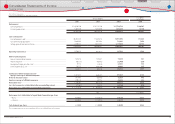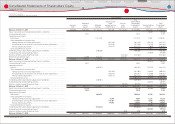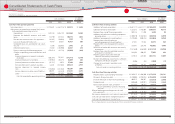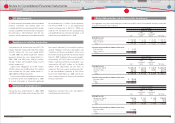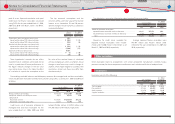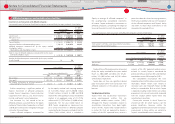Toyota 2010 Annual Report Download - page 70
Download and view the complete annual report
Please find page 70 of the 2010 Toyota annual report below. You can navigate through the pages in the report by either clicking on the pages listed below, or by using the keyword search tool below to find specific information within the annual report.
68
TOYOTA ANNUAL REPORT 2010
The allowance for residual value losses is
maintained in amounts considered by Toyota
to be appropriate in relation to the estimated
losses on its owned portfolio. Upon disposal
of the assets, the allowance for residual losses
is adjusted for the diff erence between the net
book value and the proceeds from sale.
Inventories
Inventories are valued at cost, not in excess of
market, cost being determined on the average-
cost basis, except for the cost of fi nished products
carried by certain subsidiary companies which is
determined on the specifi c identifi cation basis
or last-in, fi rst-out (LIFO) basis. Inventories
valued on the LIFO basis totaled ¥150,110 million
and ¥199,275 million ($2,142 million) at March
31, 2009 and 2010, respectively. Had the fi rst-in,
fi rst-out basis been used for those companies
using the LIFO basis, inventories would have
been ¥58,980 million and ¥64,099 million ($689
million) higher than reported at March 31, 2009
and 2010, respectively.
Property, plant and equipment
Property, plant and equipment are stated at
cost. Major renewals and improvements are
capitalized; minor replacements, maintenance
and repairs are charged to current operations.
Depreciation of property, plant and equipment
is mainly computed on the declining-balance
method for the parent company and Japanese
subsidiaries and on the straight-line method for
foreign subsidiary companies at rates based on
estimated useful lives of the respective assets
according to general class, type of construction
and use. The estimated useful lives range from 2
to 65 years for buildings and from 2 to 20 years
for machinery and equipment. Vehicles and
equipment on operating leases to third parties
are originated by dealers and acquired by certain
consolidated subsidiaries. Such subsidiaries are
also the lessors of certain property that they
acquire directly.
Vehicles and equipment on operating leases
are depreciated primarily on a straight-line
method over the lease term, generally from
2 to 5 years, to the estimated residual value.
Incremental direct costs incurred in connection
with the acquisition of operating lease contracts
are capitalized and amortized on a straight-line
method over the lease term.
Long-lived assets
Toyota reviews its long-lived assets for
impairment whenever events or changes in
circumstances indicate that the carrying amount
of an asset group may not be recoverable. An
impairment loss would be recognized when the
carrying amount of an asset group exceeds the
estimated undiscounted cash fl ows expected to
result from the use of the asset and its eventual
disposition. The amount of the impairment loss
to be recorded is calculated by the excess of
the carrying value of the asset group over its fair
value. Fair value is determined mainly using a
discounted cash fl ow valuation method.
Goodwill and intangible assets
Goodwill is not material to Toyotas consolidated
balance sheets.
Intangible assets consist mainly of software.
Intangible assets with a defi nite life are amortized
on a straight-line basis with estimated useful
lives mainly of 5 years. Intangible assets with
an indefi nite life are tested for impairment
whenever events or circumstances indicate that
a carrying amount of an asset (asset group) may
not be recoverable. An impairment loss would
be recognized when the carrying amount of
an asset exceeds the estimated undiscounted
cash fl ows used in determining the fair value of
the asset. The amount of the impairment loss
to be recorded is generally determined by the
diff erence between the fair value of the asset
using a discounted cash fl ow valuation method
and the current book value.
Employee benefi t obligations
Toyota has both defi ned benefi t and defi ned
contribution plans for employees retirement
benefi ts. Retirement benefi t obligations are
measured by actuarial calculations in accordance
with U.S. GAAP. The overfunded or underfunded
status of the defi ned benefi t postretirement
plans is recognized on the consolidated balance
sheets as prepaid pension and severance costs
or accrued pension and severance costs, and the
funded status change is recognized in the year
in which it occurs through other comprehensive
income.
Environmental matters
Environmental expenditures relating to current
operations are expensed or capitalized as
appropriate. Expenditures relating to existing
conditions caused by past operations, which do
not contribute to current or future revenues, are
expensed. Liabilities for remediation costs are
recorded when they are probable and reasonably
estimable, generally no later than the completion
of feasibility studies or Toyotas commitment to a
plan of action. The cost of each environmental
liability is estimated by using current technology
available and various engineering, fi nancial and
legal specialists within Toyota based on current
law. Such liabilities do not refl ect any off set for
possible recoveries from insurance companies
and are not discounted. There were no material
changes in these liabilities for all periods
presented.
Income taxes
The provision for income taxes is computed
based on the pretax income included in the
consolidated statement of income. The asset and
liability approach is used to recognize deferred
tax assets and liabilities for the expected future
tax consequences of temporary diff erences
between the carrying amounts and the tax bases
of assets and liabilities. Valuation allowances are
recorded to reduce deferred tax assets when it is
more likely than not that a tax benefi t will not be
realized.
Derivative fi nancial instruments
Toyota employs derivative fi nancial instruments,
including forward foreign currency exchange
contracts, foreign currency options, interest rate
swaps, interest rate currency swap agreements
and interest rate options to manage its exposure
to fl uctuations in interest rates and foreign
currency exchange rates. Toyota does not use
derivatives for speculation or trading purposes.
Changes in the fair value of derivatives are
recorded each period in current earnings
or through other comprehensive income,
depending on whether a derivative is designated
as part of a hedge transaction and the type of
hedge transaction. The ineff ective portion of all
hedges is recognized currently in operations.
Net income attributable to Toyota Motor
Corporation per share
Basic net income attributable to Toyota Motor
Corporation per common share is calculated by
Financial Section
Financial Section
Investor Information
Corporate Information
Special Feature
Consolidated
Performance Highlights
Business Overview
Top Messages
Notes to Consolidated Financial Statements






